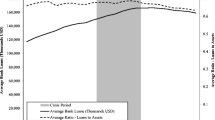Abstract
We investigate the leverage cycle in Luxembourg’s banking sector using individual bank-level data for the period 2003 Q1–2010 Q1. One of our findings is that Luxembourg’s banks have a procyclical leverage. This procyclicality is not due to marking-to-market but because Luxembourg’s banks are liquidity providers to the EU banking sector. We then empirically investigate the role of bank characteristics as well as real, financial and expectation variables that proxy for macroeconomic conditions in the pre-crisis and crisis period. We find that off-balance sheet exposures have different effects in the pre-crisis and crisis period, and that the share of liquid assets in the portfolio only affects security holdings. As for macroeconomic variables, we find that the Euribor-OIS spread is a significant driver of the build-up in leverage in the pre-crisis period. The reason is that most banks in Luxembourg are either branches or subsidiaries. This makes leverage a less relevant indicator of riskiness for investors. It also implies that in times of liquidity shortages, mother companies or groups demand further liquidity from their branch or subsidiary. The downturn in leverage during the crisis can be accredited to reductions in expectations, which we proxy by an economic sentiment indicator. It can also be explained by increasing bond prices which induce depositors to shift their funds from bank deposits into bonds. We find no important role for GDP growth.
Similar content being viewed by others
References
Allen F, Gale D (2007) Understanding financial crises. Oxford University Press, Oxford
Adrian T, Shin H (2010) Liquidity and leverage. J Financial Intermed 19(3): 418
Shleifer A, Vishny R (2011) Value maximization and the acquisition process. J Econ Perspect 25(1): 29
Reinhart C, Rogoff K (2008) The aftermath of financial crises. Am Econ Rev 98(2): 339
Brunnermeier M (2009) Deciphering the liquidity and credit crunch 2007–2008. J Econ Perspect 23(1): 77
Cecchetti S (2009) Crisis and responses: the federal reserve in the early stages of the financial crisis. J Econ Perspect 23(1): 51
Bernanke B, Gertler M (1989) Agency costs, net worth, and business fluctuations. Am Econ Rev 79(1): 14
Kiyotaki N, Moore J (1997) Credit cycles. J Polit Econ 105(2): 211
Arellano M, Bover O (1995) Look at instrumental variables estimation of error-component models. J Econom 68(1): 29
Blundell R, Bond S (1998) Initial conditions and moment restrictions in dynamic panel data models. J Econom 87(1): 115
Nickell S (1981) The econometric analysis of transition data. Econometrica 49(6): 1417
Author information
Authors and Affiliations
Corresponding author
Additional information
The views and opinions expressed in this article are those of the authors and do not necessarily reflect those of the Banque Centrale du Luxembourg.
Rights and permissions
About this article
Cite this article
Giordana, G., Schumacher, I. What are the bank-specific and macroeconomic drivers of banks’ leverage? Evidence from Luxembourg. Empir Econ 45, 905–928 (2013). https://doi.org/10.1007/s00181-012-0643-8
Received:
Accepted:
Published:
Issue Date:
DOI: https://doi.org/10.1007/s00181-012-0643-8




